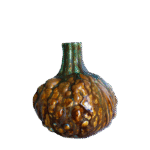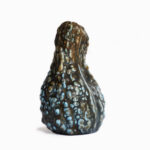Gilbert Méténier
Biography
Gilbert Méténier (1880–after 1940) naturally followed the family tradition in ceramics. By 1901, he was already experienced and seeking work as a production manager for tiles, bricks, or stoneware. By 1907, he demonstrated mastery in all aspects of the craft, including modeling and enameling.
Around 1910, Gilbert and his father, Louis Méténier, both ceramists and business partners, settled in Gannat, near Moulins, where they lived at 1 Rue du Mouchet. Louis had co-founded in 1906 the Société des Tuileries Mécaniques de Gannat, which became the Electro-Réfractaire in 1908, producing sanitary ware, stoneware, enamelled tiles, refractory bricks, and artistic ceramics.
During World War I, Gilbert, exempted from active military service due to a thigh fracture, was officially described as a “manufacturer of art ceramics,” producing works distinguished by their decorative qualities rather than purely functional use. Together with his father, he developed what became known as Grès d’Art Méténier, pieces signed by Gilbert alone. The production included vases, pitchers, lamp bases, planters, and smoking or coffee sets, all executed in numerous glaze variations.
In addition to mass-produced items, Gilbert created rare, highly original pieces, often small vases shaped like plants, demonstrating exceptional skill as a modeler. Following Louis Méténier’s death on May 10, 1922, Gilbert expanded the factory, adding a second kiln to meet growing demand. Oak from the nearby Colettes forest was used to fuel the wood-fired kilns, while clay from Echassières, rich in kaolin, provided a fine white paste. After shaping in molds, the forms were dried, refined, and glazed, mostly by hand with metal oxides such as copper and iron, producing distinctive color effects. Gilbert personally oversaw glaze formulation, mold creation, and firing, ensuring the highest artistic quality.
The Méténier ceramics were distributed primarily to major Parisian department stores, tourist locations, and spa towns, including Vichy and Roanne, as well as through international outlets, notably in La Chaux-de-Fonds, Switzerland. The workshop did not operate through catalogs; instead, photographs and miniature samples were used to promote the products.
The Grès d’Art Méténier factory closed with the German occupation of France on June 18–19, 1940. Reportedly, Gilbert destroyed all molds to prevent them from falling into German hands. He subsequently moved with his family to the Var region, where his later life remains undocumented.


